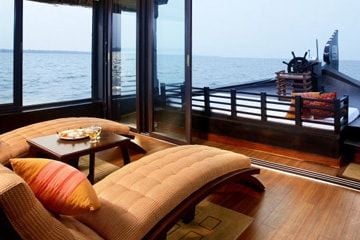 Today trained art restorers work their magic to give ancient pieces of art a new lease of life. Art infuses our lives – from the banal to the exalted. Not everyone can have a statue of Michelangelo’s David in his or her living room but it is there, in Florence, awaiting your visit.
Today trained art restorers work their magic to give ancient pieces of art a new lease of life. Art infuses our lives – from the banal to the exalted. Not everyone can have a statue of Michelangelo’s David in his or her living room but it is there, in Florence, awaiting your visit. Closer to home, most people eat off delicate ceramic and porcelain tableware, yet its utilitarianism does not detract one from its inherent beauty. Art’s vast and stimulating terrain encompasses all – metal work, pottery, sculpture, woodwork and paintings. Paintings, on the other hand, will always be talked about in more authoritarian tones. Experts will critique the latest star on the firmament; art gallery curators will push yet another talent and eager buyers will queue up for a slice of the new colourful palette. How do paintings evolve and culminate as a finished piece of expression? In many cases, this is a labour of love and many hours of toil locks a secret, which only an intimate will be able to uncover.
Robert Browning put it succinctly in a poem called, The Last Duchess: “Fra Pandolf chanced to say, “Her mantle laps over my lady’s wrist too much” or “Paint must never hope to reproduce the faint half-flush that dies along her throat.” The above lines are evocative of the perfection of the duchess’ beauty and the skill of the painter.
In the poem, a duke is showing a guest this painting of his wife done by a friar, Fra Pandolf. The monk has recreated the curve of her cheeks with just the right tinge of blush gracing her throat. The duke speculates that the lovely flush of her skin, may be due to a comment by the chaste monk on her mantle lapping her “wrist too much”.
Here, the duke insinuates that an austere monk may have dared to flirt with his beautiful wife and she may have been glad to receive his attentions. Thus, the painting reveals both the duke’s suspicions and the sheer talent of the painter. The painting became for the duke, a living memory of his wife’s youth, beauty and suspected infidelity.
The painter had done her justice. The painting immortalised the duchess’ beauty for posterity to admire, while in reality the duke had her killed in a fit of possessive rage. With so much art gracing so many homes, it is inevitable that it needs taking care of. If only the usual phadka (swipe) with a dust cloth would do! But priceless investments need time and sometimes professional care.
So what do you do, if you see paint chipping off from your Hussains, Aras or Vaikunthams? There is no need to panic and call your insurance company to see if it is a fake. It would be best to take it to an art restorer. Paintings are now purchased as much for their investment value as for their intrinsic visual appeal. They add value to the écor of a home and require as much upkeep as the family silver. This is when art restorers come into the picture.
A restorer’s sure and steady hand scrapes, peels and retouches paintings. Colours are brought back to life and grime is peeled away from the surface of paintings. Any normal wear and tear is also taken care of by their able hands. A painting may deteriorate owing to many reasons, the chief ones being: fungus, which spreads over its surface, grows through surface layers and breaks pigment particles. A more concerted invasion of the painting causes a powdering of the weakened paint.
The second is the environment, where a sudden change in conditions can harm a painting. Water seepage through walls also damages paintings because microbes in water attack the binding media. Every restorer has a particular technique that he/she prefers and perfects. It is almost akin to leaving your signature on the renewed work of art. The only thing in common restorers have is the fundamental process. Art restorers by and large follow the same guidelines.
All paintings have definite structure, layer upon layer, which finally gives birth to a masterpiece. For instance, an oil painting has:
1. Auxiliary support: It is usually the stretcher or strainer made of wood.
2. Primary support: Material on which the painting is done. Generally it is canvas made of cotton, linen, jute, paper or board.
3. Ground: Usually the glue or glue pigment with inert material.
4. Priming: A layer of colour is applied before a painting is executed.
5. Paint layer: Includes layer of paint, drawing or under painting.
6. Protective coating: Generally this is a final layer of varnish over the painted surface
Here are some sure-fire tips towards restoring art:
1. Condition: The first thing to determine is the condition of the
painting and what surface it has been painted on. It could be cloth, wood (even plywood) or jute canvas. Then, the medium needs to be checked – whether it is oil (also called royal medium), water or acrylic. Acrylic paints are soluble in water, and after drying turn to plastic. This provides durability as well as the same effect as oil paint.
2. Clean the surface: This is the risky bit because chemicals are used to clean out the dust and fungus collected on the surface of the painting. It is also time consuming, where every part of the painting has to be cleaned very minutely – sometimes a square inch at a time for a badly damaged work. Paintings coloured over
by amateurs pose a far greater problem. These additional layers have to be removed to get down to the original colours. If not done correctly and carefully, the base surface could get destroyed.
3. Retouching: This is where the play of light and colour comes into its own. To figure out the artist’s original shades and tones and to duplicate them is almost like creating the painting afresh. This is all about the skill of those magical fingers. Some restorers trust their intuition and others let the paintings speak to them and guide them.
 ‘Western’ colours (these colours are unique to a specific brand of paints, especially a foreign brand like Winsor & Newton, and may be almost impossible to duplicate) are the hardest to figure out. Even if a painter were to be observed at work, it would be hard to tell just how much of this and that colour has gone into making a third shade.
‘Western’ colours (these colours are unique to a specific brand of paints, especially a foreign brand like Winsor & Newton, and may be almost impossible to duplicate) are the hardest to figure out. Even if a painter were to be observed at work, it would be hard to tell just how much of this and that colour has gone into making a third shade. So imagine going at it blindfolded! To get just the exact colour is a mark of excellence. A poor restoration job will show blotches that are more prominent than the painting itself. The weaves of the new canvas should exactly match the original or else it will disturb the visual continuity after retouching is done.
4. Varnish: This comes in two types – matt lacquer and glossy finish. The restored painting is varnished to protect it from the weather and to preserve the colours. Then the painting is waxed. Wax is melted and applied to the back of the painting. This prevents moisture from seeping in from behind and ruining the painting. Kashinath Salve, painter and former professor at JJ School of Fine Arts has just restored a Laxman Shreshta.
His expert advice for those interested in preserving art is: “Pencil drawings, charcoal sketches and even oil and acrylic paintings are easier to restore while watercolours are the most difficult.” Salve is the person most people in the know go to, to rescue their paintings. For instance, recently, he was asked to work his magic on a Jehangir Sabhavala. So, his is the expertise you would need to bring your paintings back to life.
Every restorer has a particular technique that he/she prefers and perfects.It is almost akin to leaving your signature on the renewed work of art
In India, one of the premier restoration institutions is The Indian National Trust for Arts and Cultural Heritage (INTACH) in New Delhi–the umbrella body looking into the preservation of art. INTACH has 11 conservation institutes all over India, which preserve priceless artefacts for generations to come.
In 1998, INTACH’s Delhi Conservation Centre in collaboration with NGMA restored some Raja Ravi Verma and Amrita Sher-Gil paintings, which are now in private collections. The results are there for all to see – in glorious technicolour detail. Western art restorers have begun and possibly perfected a new technique, which may catch up here in India.
The surface of the painting is coated with a chemical, which adheres to the painting so it can be copied backwards onto another surface. This is then lifted and mounted on to a new base. Apparently, using a similar technique, sometimes a painting is copied on to glass as well. All restorers keep updating their skills. Some have specialised in restoration from art schools in England and USA. Some are painters who are called in to gauge the right colours. The brush once taken up can become
quite addictive. The instinctive nature of art calls out to myriad souls, to help it when in distress. Paintings are no exception. They obsess those who possess them.!
Information:
INTACH, 71, Lodhi Estate, New
Delhi – 110003. Tel no: 011-4641304/
011-4645482. Fax: 011-4611290
INTACH’s Mumbai chapter may be
starting courses in art conservation
shortly. For further information call:
022-22843644 or e-mail:intach1@vsnl.com
Kashinath Salve, an accomplished restorer who is a painter at heart can be contacted at: Robert Money Vocational Institute, Academy of Fine Arts, Next to Queen Mary School, Grant Road, Mumbai. Tel no: 022-23812043. He also conducts courses in pottery, minakari work on copper and painting in all mediums at the Academy. Art materials are given to those who enroll. Open from Monday to Saturday, 11 am to 7 pm.
Sources for this article: Examination & Conservation of Wall Paintings, edited by OP Agrawal, Published by Sandeep Prakashan. ICCI Newsletter No. 31, Sept 2002.
Photos courtesy catalogue: Raja Ravi Varma, Amrita Sher-Gil Restored by Indian National Trust for Art and Cultural Heritage (INTACH) in collaboration with National Gallery of Modern Art (NGMA).
Written for Jetwings - Jet Airways' in-flight magazine




















